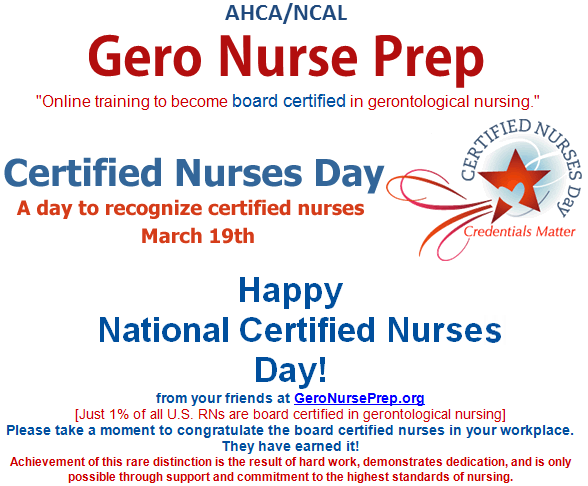Doctors Take A Long Shot And Inject HIV Into Dying Girl. The Reason Why Will Amaze You.
Category: Gero Nurse Prep Resources
Gero Nurse Prep Faculty Advocates for Pressure Ulcer Awareness
Pressure ulcers – commonly called bedsores — are a big problem in the United States. More than 2.5 million U.S. residents develop pressure ulcers every year, with about 60,000 people dying each year from pressure ulcer complications.
Today is International Stop Pressure Ulcer Day, a day dedicated to bringing awareness to the causes and ways to prevent pressure ulcers.

“This is not just a problem for patients and their families, but also health facilities,” said Joyce Black, Ph.D., associate professor in UNMC’s College of Nursing, who is recognized as a national expert in pressure ulcers. “The government won’t reimburse for Medicare and Medicaid expenses if patients get pressure sores.”
Pressure ulcers can develop in as little as three hours as a result of sitting or lying too long in the same position, she said. Those who are bedridden are most at risk, including those in hospitals and long term care facilities like nursing homes. It can happen in the home as well.
“Ulcers develop quickly depending on how hard the surface is that you’re on and how much fat padding a person has,” Dr. Black said. “Thin, frail individuals develop them more quickly.”
She said pressure ulcers develop due to pressure on the soft tissues when patients don’t move or continuously slide down in a chair. The blood in the area stops and the tissue dies. Most problems with ulcers occur on the buttocks, tailbone and the heel of the foot.
Tips on prevention and treatment
Dr. Black has these tips for preventing and treating minor pressure ulcers.
- Sit or lay in different position, walk if you can.
- Stay off the sore spot until the pain or red or purple color goes away.
- Put a pillow under the calf of the leg to keep the heel off of the bed.
- Don’t rub the skin. It may tear.
- Keep skin clean. The healthier you can keep skin the less chance of skin breakdown.
- Make sure diapers get changed.
- Turn individuals every three hours if they are on a good mattress. Every two hours if mattress is thin, frayed or worn.
- Cover wound with dressing or apply topical antibiotic to keep wound clean.
- Ask what the facility is doing to reduce or prevent bed sores and if you can help.
- Ask how they are turning your loved one to get them off their back (individual should be turned on their sides-family members can help).
- Ask what kind of mattress the patient is sleeping on. An old spring mattress with an inch padding is not adequate. Family may be well advised to go to a bedding store and get two inches of memory foam so there is more padding on the bed.
- Make sure the patient is eating a well-balanced meal (not junk food).
Reference:
- UNMC News, “JOYCE BLACK, PH.D., Highlights Dangers of Pressure Ulcure” – http://app1.unmc.edu/PublicAffairs/TodaySite/sitefiles/today_full.cfm?match=11962&pk_campaign=email&pk_kwd=Joyce_Black_PhD_highlights_dangers_of_pressure_ulcers
Perspectives On Aging
Showing We Care
Since the 1990s, physicians and patients have been fighting over futility. The doctors look at a patient who is dying and say that further tests and treatment cannot possibly work and shouldn’t be done. The patients, or more commonly their families, look at those same patients and say that they want “everything done” to try to prolong life.
As often happens in the US, the futility battle ended up in the court room. In the case of Helga Wanglie, an 86-year-old woman in a vegetative state after hip surgery, the doctors went to court over whether the patient’s husband had the right to insist that she remain on a ventilator. The court, as also often happens, didn’t address the issue of whether the ventilator was or was not appropriate treatment for Mrs. Wanglie; it simply ruled that her husband, as her surrogate, had the right to make the decision. After that case, many physicians concluded that the fight over futility was itself futile. For the last 15 years, physicians have tried to focus on determining a patient’s goals of care and then suggesting what treatments are most consistent with those goals. When they still cannot agree with family members about the right course of action, they resort to mediation, sometimes provided by a hospital ethics committee. But simmering below the surface, conflicts over perceived futility rage bubble vigorously.
A short article in the New England Journal of Medicine, “The Debt of Life—Thai Lessons on a Process-Oriented Ethical Logic,” offers a refreshing way of looking at futility. Based on his experiences doing ethnographic field work in Thailand while a graduate student in Anthropology, physician Scott Stonington shines a new light on the typical ICU dilemma. The physicians, he reports, are loathe to perform various possible tests and treatments because they think in terms of outcomes. They argue that their interventions won’t work in the sense that they won’t overcome the existing medical problems and that they are burdensome to the patient and, parenthetically, expensive. The patient’s family, he observes, think in terms of the process of care. He comments on one Thai family who said that their father had given them “flesh, blood, and breath” so they had a “debt of life” to pay. The ICU, they reasoned, allowed them to repay their debt: it gave their father flesh (tube feedings for nutrition), blood (intravenous medications and dialysis to cleanse the blood), and breath (a ventilator for breathing). The family was not so much interested in the outcome of treatment as in the treatment itself. In this scenario, the conflict was ultimately resolved when the family came to the conclusion that they had paid their debt and further aggressive care could be discontinued.

I made a very similar argument in my essay, “The Standard of Caring: Why Do We Still Use Feeding Tubes in Patients with Advanced Dementia?” I noted that it had been over 10 years since a series of studies in the medical literature reported that feeding tubes (a tube inserted into the stomach to provide nutrition) did not prolong life in patients with advanced dementia who had eating difficulties. These patients are nearing the end of their lives and no matter what procedures they have, their prognosis remains pretty much the same. Not only don’t the tubes prolong life, but they don’t accomplish a variety of other goals that doctors had hoped they might: preventing pressure ulcers (skin breakdown that is often related to malnutrition) or preventing pneumonia (caused by food going into the lungs instead of the stomach). As a result of these studies, the rate of tube feeding people with advanced dementia has declined, but it is still far from zero. I suggest that the reason some families want a feeding tube is to show that they care. It’s not that they expect to improve some quantifiable outcome—living longer or avoiding pneumonia. It’s that they want to have a way to demonstrate caring. For the same reason, we keep people with advanced dementia clean and dressed. We don’t require a study that shows that they will be less likely to develop an infection if they are kept clean. We don’t demand proof that they will live longer if they are clothed. We assume that being clean and clothed contribute to well-being because they are among the only ways we as caregivers have of showing respect for the human being who happens to have dementia. Tube feeding, from this perspective, is a means of proving that we care.
Resource:
Murriel Gillick, “Showing we care”, http://blog.drmurielgillick.com/2013/11/showing-we-care.html
ANCC Board Certification Nursing Conference
Submit by November 10, 2013
Stand out among your board-certified nurse peers by presenting your clinical expertise, best practices, or research at the ANCC Board Certification Nursing Conference™ next March!
Abstract proposals for live posters and concurrent podium sessions may now be submitted online. You must be a certified nurse to submit.
The deadline for abstract submissions is 11:59 p.m. on November 10, 2013.
Abstracts will be considered based on how well they fulfill the goal and learning objectives of the conference. The goal of the ANCC Board Certification Nursing Conference is for APRN and specialty nurses to improve their clinical practice while pursuing professional development for continuing education credit and certification renewal.
More Info can be found here- http://edirectreach.com/CLIENTS/ANCC/30-certcon/
AHCA/NCAL Gero Nurse Prep Demo Site
New Feature! Check out the latest at Gero Nurse Prep! We have prepared a demo site to help you decide if Gero Nurse Prep is right for you. The demo contains a sampling of choice topics, and was constructed with the look and feel of the full course.

Access the demo, and find out more information about the full course at www.geronurseprep.org
Exclusive Offer | Gero Nurse Prep
Stop by booth #501 and I’ll tell you how you can increase the quality of care and lower costs in your facility!
We hope to see you at the AHCA/NCAL Annual Convention in Phoenix! Stop by booth #501 and I’ll tell you how you can increase the quality of care and lower costs in your facility!
Gero Nurse Prep is a proven online certification training program that prepares RNs to become board certified in gerontological nursing.
Why is this important to you?
- Higher quality of care
- Fewer adverse events
- Higher RN job satisfaction – retention
- Reduced turnover – lower costs
- Happier nurses, residents, families and facility owners
- Stronger referrals and marketing
Act Now!
Visit www.geronurseprep.org today to register your RNs. You can also like us on Facebook and follow us on Twitter, and comment on our blog!
Hurry!
Current tuition incentive: 50% off or FREE tuition for your CNO or DON ends December 31!

More information:
There are over 600 RNs enrolled in Gero Nurse Prep and alums have a 98% pass rate on the ANCC certification exam.
- Click here for some Fast Facts.
- Click here for a Course Overview.
- Contact 402-559-6565 or concne@unmc.edu.
Get Recognized for Your Achievement!
Calling all Gero Nurse Prep Grads!
We need your help! Provider magazine, published by the American Health Care Association and the National Center for Assisted Living (AHCA/NCAL), the major associations for the long term and post-acute care industry, would like to honor nurses who have become board certified after completing Gero Nurse Prep. AHCA/NCAL would also like to recognize you in other print and online advertisements related to Gero Nurse Prep.
To take advantage of this opportunity for public recognition of your achievement, call Anji Wittman at 402-559-6565 by June 7!
Join the Discussion!
Hello Gero Nurse Prep Learners! We are having a great discussion in the Module 4 forum on non-pharmalogical pain control. I would love to see your thoughts on this topic! I am sure many of you have some great ideas that you can share. Maybe you can add to our thought about aromatherapy for pain? Log into GeroNursePrep.org and find us in the Module 4 forum (You can also add a comment on our Facebook page!). I hope to see you there! -Heidi-
New Interactive Features
We have added new interactive features!
• Certification exam test simulator! This 50 question simulator is designed to give you timed test practice just as it will be during your ANCC certification exam! The simulator in the End of Course Activities section, and is available when you are finished with all 10 modules, 4 milestones, end of course comprehensive posttest, and course evaluations. Remember, practice makes perfect! And in this case, practice makes confident, board-certified nurses!
• End of Course Forum! This is where you can share course tips, test experiences, and other nursing experiences with fellow Gero Nurse Prep students. We would love to know about your success with the ANCC certification exam and beyond! Help others to succeed by sharing your course experiences with us! Join the discussion!
Happy Certified Nurses Day
Certified Nurses Day is an annual day of recognition for and by healthcare leaders dedicated to nursing professionals, excellence, recognition and service. We congratulate the board certified nurses in your workplace.

